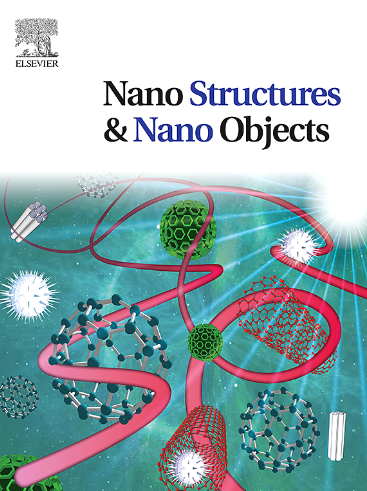快速合成掺钾FeS2纳米肥料促进S22番茄种子萌发和植株生长
IF 5.45
Q1 Physics and Astronomy
引用次数: 0
摘要
纳米肥料在纳米尺度上为商业肥料提供了一种可持续和有效的替代品,并因其农业效率而受到称赞。NFs旨在促进植物生长和土壤健康,同时减少商业肥料的环境足迹。本研究主要研究了钾掺杂二硫化铁纳米颗粒(k掺杂FeS2或KFS NPs)的合成和表征。KFS对植物代谢和抗逆性至关重要,而FeS2在改善土壤微量养分有效性和硫含量方面发挥着重要作用。采用简单的绿色合成方法,以花生果皮为燃料制备KFS NPs。利用x射线衍射(XRD)、扫描电子显微镜(SEM)、透射电子显微镜(TEM)、元素分析、EDAX和傅里叶变换红外光谱(FT-IR)等先进技术对NFs的结构和形态特性进行了证实。XRD谱图与FeS2的标准JCPDS No. 71-53强烈对齐,表明其属于立方黄铁矿相,晶体边长均等于5.4281 Å,与Pa-3空间基团有关。TEM分析显示KFS NPs的立方结构,并显示在20 mg/2 mL的剂量下萌发显著。KFS NPs在促进植物生长、叶绿素和类胡萝卜素水平方面比商品肥料更有效。施用NFs处理的植株叶绿素含量为22.41 mg/g,高于施用商品肥料(11.07 mg/g)和对照(4.3 mg/g)。与对照(3.55 mg/g)和商业肥料(6.55 mg/g)相比,kfs处理(叶面喷雾)番茄的类胡萝卜素含量(14.87 mg/g)更高。kfs - nps处理的番茄中抗坏血酸浓度最高(67.7 mg/mL),蛋白质含量最高(2139.956 µg/mL)。研究结果表明,KFS - NFs在农业中具有多功能作用。它为解决营养效率低下、土壤退化和环境污染等全球挑战提供了一种生态友好的方法。本文章由计算机程序翻译,如有差异,请以英文原文为准。
Facile synthesis of potassium doped FeS2 nanofertilizers to enhance seed germination and plant growth in S22 tomato seeds
Nanofertilizers (NFs) provide a sustainable and effective alternative to commercial fertilizers at the nanoscale and they have been praised for their agricultural efficiency. NFs are designed to enhance plant growth and soil health while reducing the environmental footprint of commercial fertilizers. This study focuses on the synthesis and characterization of Potassium-doped Iron disulfide nanoparticles (K-doped FeS2 or KFS NPs). KFS is essential for plant metabolism and stress tolerance, with FeS2 known for its role in improving soil micronutrient availability and sulfur content. A simple green synthesis approach was used to produce KFS NPs with Arachis hypogaea peel as a fuel. The structural and morphological properties of the NFs were confirmed using advanced techniques such as X-ray diffraction (XRD), scanning electron microscopy (SEM), transmission electron microscopy (TEM), as well as elemental analysis, EDAX and Fourier transform infrared spectroscopy (FT-IR). XRD patterns are strongly aligned with the standard JCPDS No. 71–53 of FeS2, signifying that they belong to the cubic pyrite phase with all the sides of the crystal being equal to 5.4281 Å, associated with the Pa-3 space group. TEM analysis shows the cubic structures of KFS NPs and demonstrates significant germination at a dosage of 20 mg/2 mL. KFS NPs were more effective than commercial fertilizers in enhancing plant growth, chlorophyll and carotenoid levels. Plants treated with NFs have a higher chlorophyll content of 22.41 mg/g than plants treated with commercial fertilizer (11.07 mg/g) and control (4.3 mg/g). KFS-treated (foliar spray) tomatoes have a higher carotenoid content (14.87 mg/g) compared to Control (3.55 mg/g) and commercial fertilizer (6.55 mg/g). The concentration of ascorbic acid was highest in the test sample of (67.7 mg/mL) of KFS-treated tomato and protein content was found to be highest in KFS-NPs-treated tomatoes (2139.956 µg/mL). Findings suggest that KFS NFs hold the multifunctional role in agriculture. It provides an eco-friendly approach to address global challenges such as nutrient inefficiency, soil degradation and environmental pollution.
求助全文
通过发布文献求助,成功后即可免费获取论文全文。
去求助
来源期刊

Nano-Structures & Nano-Objects
Physics and Astronomy-Condensed Matter Physics
CiteScore
9.20
自引率
0.00%
发文量
60
审稿时长
22 days
期刊介绍:
Nano-Structures & Nano-Objects is a new journal devoted to all aspects of the synthesis and the properties of this new flourishing domain. The journal is devoted to novel architectures at the nano-level with an emphasis on new synthesis and characterization methods. The journal is focused on the objects rather than on their applications. However, the research for new applications of original nano-structures & nano-objects in various fields such as nano-electronics, energy conversion, catalysis, drug delivery and nano-medicine is also welcome. The scope of Nano-Structures & Nano-Objects involves: -Metal and alloy nanoparticles with complex nanostructures such as shape control, core-shell and dumbells -Oxide nanoparticles and nanostructures, with complex oxide/metal, oxide/surface and oxide /organic interfaces -Inorganic semi-conducting nanoparticles (quantum dots) with an emphasis on new phases, structures, shapes and complexity -Nanostructures involving molecular inorganic species such as nanoparticles of coordination compounds, molecular magnets, spin transition nanoparticles etc. or organic nano-objects, in particular for molecular electronics -Nanostructured materials such as nano-MOFs and nano-zeolites -Hetero-junctions between molecules and nano-objects, between different nano-objects & nanostructures or between nano-objects & nanostructures and surfaces -Methods of characterization specific of the nano size or adapted for the nano size such as X-ray and neutron scattering, light scattering, NMR, Raman, Plasmonics, near field microscopies, various TEM and SEM techniques, magnetic studies, etc .
 求助内容:
求助内容: 应助结果提醒方式:
应助结果提醒方式:


